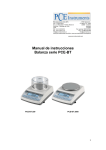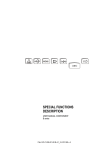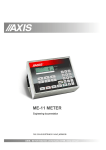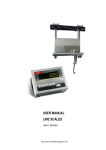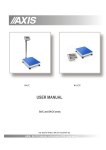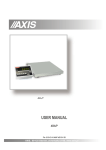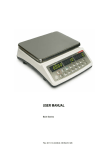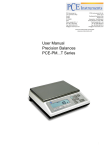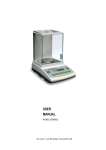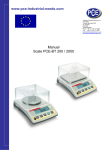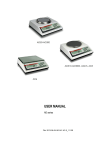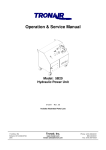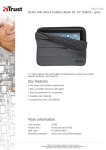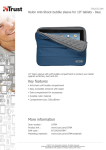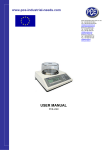Download USER MANUAL
Transcript
USER MANUAL BDM SERIES File: 2012-01-BDM-137 btA052 GB 2 USER MANUAL __________________________________________________________________________________________________________________ Contents: 1. General description ............................................................................................................................ 3 2. Completeness .................................................................................................................................... 3 3. Safety rules ........................................................................................................................................ 4 4. Technical data .................................................................................................................................... 5 5. General scale view ............................................................................................................................. 6 6. Keys and indicators ............................................................................................................................ 7 7. Preparing working environment .......................................................................................................... 8 8. Preparing scale to work ...................................................................................................................... 8 9. General operation principles .............................................................................................................. 9 10. Operation rules during work with accumulators (batteries) ............................................................... 10 11. Accumulators (batteries) replace ...................................................................................................... 10 12. Start-up ............................................................................................................................................ 12 13. Connection with computer or a printer.............................................................................................. 12 14. Basic scale functions ........................................................................................................................ 14 14.1. Simple weighing .............................................................................................................................. 14 14.2. Weighing with tare........................................................................................................................... 14 15. Special functions .............................................................................................................................. 15 15.1. Customization of special functions menu (ACtIV and dEFAULt) ..................................................... 17 15.2. Autozeroing function (Autotar)......................................................................................................... 18 15.3. Pieces counting function (PCS)....................................................................................................... 19 15.4. Function for changing mass unit (UnIt) ........................................................................................... 20 15.5. Percent calculation functions (PErC).............................................................................................. 21 15.6. Function for summing recipe ingredients (rECIPE) ......................................................................... 22 15.7. Function for calibration with external weight (CALIb) ...................................................................... 23 15.8. Label choosing function (LAbEL) .................................................................................................... 24 15.9. Function for setting serial interface parametr (SErIAL) ................................................................... 25 15.10. Printout configuration (PrInt) ......................................................................................................... 26 15.11. Animal weighting function (LOC) ................................................................................................... 27 15.12. Tare memory function (tArE) ......................................................................................................... 28 15.13. Maximum value indication function (UP) ....................................................................................... 30 15.14. Force measuring function (nEWton).............................................................................................. 31 15.15. Anty-disturbance filter option (FILtEr)............................................................................................ 31 15.16.Setting backlight function (b_LIGHt)............................................................................................... 32 15.17. Function for choosing reading unit (rESOLUt)............................................................................... 32 15.18. Statistical calculations function (StAt) ........................................................................................... 33 15.19. Basis weight of paper counting function (PAPEr) .......................................................................... 36 15.20. Charging accumulators function (bAttErY) .................................................................................... 37 15.21. Automatic switching off function (Auto OFF) ................................................................................. 38 15.22. Total weight function (totAL).......................................................................................................... 39 15.23. Date and time setting (dAtE) ......................................................................................................... 41 15.24. Function of comparing with preset threshold values (trESh) ......................................................... 42 16. Troubleshooting and maintenance ................................................................................................... 45 Declaration of Conformity......................................................................................................................... 46 USER MANUAL 3 __________________________________________________________________________________________________________________ 1. General description BDM series scales are destined for general use in stores, in production control, for sorting etc. Scales comply with safety regulations of European Union, what CE mark on name plate informs about, and can be used for purposes where EC verification is not required. NACE classification: 33.20.31. 2. Completeness Standard set consists of: 1. Scale 2. Pan support 3. Pan 4. Feeder 5. Accumulators – 6 pcs. (option) 6. User manual 7. Guarantee card 4 USER MANUAL __________________________________________________________________________________________________________________ 3. Safety rules It is necessary to follow safety rules of work with the scale shown below. Obeying those rules is the condition to avoid electrical shock or damage of the scale or connected peripheral devices. • All repairs and necessary regulations can be made by authorised personnel only. • To avoid fire risk use a feeder of an appropriate type (if feeder is supplied with the scale) and supply voltage has to be compatible with specified technical data. • Do not use the scale when its cover is opened. • Do not use the scale in explosive conditions. • Do not use the scale in high humidity environment. • If the scale seems not to operate properly, switch it off and do not use until checked by authorised service. According to current acts of low about protection of natural environment, wasted scales should not be put into waste containers together with ordinary waste. • Wasted scale after operation period can be delivered to units authorized for gathering wasted electronic devices or to the place where it was bought. 5 USER MANUAL __________________________________________________________________________________________________________________ 4. Technical data Scale type Capacity (Max) Reading unit (d) Tare range Pan dimensions Working temperature Weighing time Scale dimensions Scale weight Power supply Accumulators Time of continuous work with accumulators 2200mAh Time of automatic switching off the scale when working with accumulators Time of automatic switching off display backlight when working with accumulators BDM1.5 BDM3 1.5kg 0,05g -1.5kg 3kg 0,1g -3kg BDM6 BDM15 BDM30 6kg 15kg 30kg 0,2g 0,5g 1g -6kg -15kg -30kg 250x180mm -10°C ÷ +40°C <3s 255x310x107mm 2,6kg ~230V 50Hz 6VA / =12V 1,2A (external feeder) NI-MH (AA size) – 6 pcs. c.a. 6 h with display backlight c.a. 16h without display backlight > 5 min (AutoOFF function) > 30 s (b_LIGHt function) 6 USER MANUAL __________________________________________________________________________________________________________________ 5. General scale view General view: 1 2 3 4 1 – pan 2 – pan support (under pan) 3 – display 4 – keys 5 – water level 6 – rotating legs 6 5 Connectors view: ~230V Feeder Zasilacz Power Zasilanie supply 12V 500mA RS232C RxD (read) RxD (odbiór) TxD TxD (nadawanie) (transmit) masa ground 1 2 3 4 5 6 7 8 9 7 USER MANUAL __________________________________________________________________________________________________________________ 6. Keys and indicators %ct n pcs HR Max key " Min I/ →T← " B/G " →0← " MENU " " HR indicator →0← " " NET " MODE bar indicator indicator OFF " " pcs e d - switch on / switch off (standby), - taring (storing package mass subtracted from weighed mass) - showing gross mass (option), - zeroing the scale when pan is empty (option) - special function menu, - result printout, - increasing resolution of mass indication (option), - zero indicator (when scale platform is empty), - indicator of weighing result stabilisation, - net mass (after use of →T← key), - indicator of switching special function on, - indicator of scale load (0-100%). - switching scale with key (standby), - switch: special function / weighing, - indication in pieces Note: →0←, B/G and HR keys and →0←, B/G and NET indicators work only in scales with reading unit d=e. 8 USER MANUAL __________________________________________________________________________________________________________________ 7. Preparing working environment Location for the scale should be chosen with care in order to limit influence of the factors that can interrupt working scale. This location has to maintain proper temperature for working scale and necessary space for its operating. The scale should stay on stable table. Rapid air blasts, vibrations, dust, rapid temperature changes or air humidity over 90% are not allowed in scale surrounding. The scale should be far from heat sources and devices emitting strong electromagnetic or magnetic fields. 8. Preparing scale to work 1 2 5 6 1. Take the scale, pan support, pan and feeder out of the package. It is recommended to keep the original scale package in order to transport the balance safely in future. 2. Place the scale on a stable ground not affected by mechanical vibrations and airflows. 3. Insert pan support 2 into holes in scale housing. 4. Put pan 1 on pan support. 5. Level the scale using rotating legs 6 so that the air bubble in water level 5 is in the middle. If the scale was taken from a lower temperature surrounding to a room with higher temperature, e.g. in winter, moisture can liquefy on the scale casing. Do not connect power supply to the scale, because this can cause damage or improper work of the scale. In this case leave the scale for at least 4 hours unplugged for acclimatization. USER MANUAL 9 __________________________________________________________________________________________________________________ 9. General operation principles 1. In order to confirm correctness of the scale during its operation, before starting and after finishing every valid measurement series it is recommended to check weighing accuracy putting calibration weight or other object of exactly known mass on the scale. In the case when allowable measurement error of the scale is exceeded, it is recommended to perform calibration with external weight or contact authorised service centre. 2. Weighed mass should be placed in the middle of the pan. 3. The scale allows taring in the whole measuring range. To tare the scale press →T← key. Taring does not extend measuring range, but only subtracts tare value from mass value of a sample placed on the pan. To make the control of a load on the pan easier and to avoid exceeding measurement range, the scales with LCD display have load indicator calibrated 0÷100%. lights, which signalises 4. Weighing result should be read when the indicator result stabilisation. 5. When the scale is not used but it is necessary for it to be ready to work, it can be switched off by pressing I/ key. The scale reading system is then switched off and scale goes to standby mode. Switching the scale on is preformed by pressing I/ key. 6. In sales having →0← key (zeroing) active it should be checked if zero indicator →0← is displayed before sample is placed on the pan. If not, press →0← key and wait until the scale is zeroed and zero indicator appears. After that load can be placed on scale pan. 7. Scale mechanism is a precise device sensitive to mechanical shocks and strokes. Do not overload the scale more than 20% of maximum capacity. Do not press the pan with a hand. For transportation secure scale pan against accidental pressing. 10 USER MANUAL __________________________________________________________________________________________________________________ 10. Operation rules during work with accumulators (batteries) 1. Scale can be powered from ~230V supply through feeder attached with scale. Moreover accumulators, which are placed in container inside the scale, can be used for powering. Ordinary batteries can be used as well. When using batteries in place of accumulators, charging during work with feeder have to be switched off. bAttErY function is used for this purpose (bAt OFF option), which is described in further part of manual. Charging batteries can cause their breaking and serious damage of the scale. 2. In order to make accumulators (batteries) discharging time longer, automatic switching off display backlight and the whole scale further is possible during breaks in weighing. Configuration of these mechanisms is done using b_LIGHT and Auto OFF functions. 3. Charging accumulators is performed automatically after connecting feeder to the scale, also during weighing. Accumulator power level can be read using bAttErY function (bat VoL option) 11. Accumulators (batteries) replace 11 1. Open cover 11. Turning scale upside down take care that scale is not laid on the pan. Press on pan out off control can cause mechanical damage of the scale. USER MANUAL 11 __________________________________________________________________________________________________________________ 13 2. Take accumulator container 12 off and put 6 pcs. of AA accumulators in it. 12 The way of placing accumulators in container. 12 USER MANUAL __________________________________________________________________________________________________________________ 12. Start-up Plug feeder into 230V power supply socket. When the pan is empty plug feeder output connector into 12V socket at the right side of the scale. Autotests and internal calibration will be performed. Steps after start-up of the scale: C-1 Tests of electronic scale components. C-5 ------- 0.00g Zeroing the scale. Ready to work. 13. Connection with computer or a printer The scale may send data to a computer or a printer via RS232C interface. When cooperating with a computer, the scale sends weighing result after initialising signal from a computer or after pressing key on the scale. RxD (read) TxD (transmit) ground casing For cooperation with the scale a computer should be equipped with software allowing receiving data from the scale and using it further. AXIS offers computer programs to cooperate with scales, available on www.axis.pl website: - Communication – free program for sending simple commands to the scale and receiving weighing results, USER MANUAL 13 __________________________________________________________________________________________________________________ - ProCell – program for cooperation with Microsoft EXCEL and other Microsoft Windows applications (demo version). Detailed information for programmers (LONG protocol): When cooperating with a computer, the scale sends data as follows: Computer → Scale: S I CR LF (53h 49h 0Dh 0Ah) - initiating signal, Scale → Computer: scale sends 16 data according to the following format: (16 Bytes, transmission parameters: 8 bits, 1 stop, no parity, 4800 bps), Description of particular bytes: Byte 1 - „-“ sign or space Byte 2 - space Byte 3÷4 - digit or space Byte 5÷9 - digit, decimal point or space Byte 10 - digit Byte 11 - space Byte 12 - k, l, c, p or space Byte 13 - g, b, t, c or % Byte 14 - space Byte 15 - CR Byte 16 - LF WK-1 connecting wire (connects the scale with a computer/9-pin connector): SCALE COMPUTER WD-1 connecting wire (connects a scale with printer): SCALE KAFKA PRINTER The settings of internal switches in printer: SW-1 on SW-2 off SW-3 SW-4 SW-5 SW-6 SW-7 SW-8 on off off on off off 14 USER MANUAL __________________________________________________________________________________________________________________ 14. Basic scale functions In further part of this manual the following graphical symbols will be used to describe scale functions: put load on the pan 12g - take load off - press a key when indication on the left is displayed - forced change - automatic change T 14.1. Simple weighing 0.00 g T 43.04 g If indication different from zero is shown for empty pan, →T← key should be used. Weighing results should be read when indicator is displayed. 14.2. Weighing with tare 23.13 g 0.00 g 63.24 g T The scale allows taring in the whole measurement range. A sum of tare and net mass value can not exceed scale capacity (Max). USER MANUAL 15 __________________________________________________________________________________________________________________ 15. Special functions All scales, beside basic metrological functions like weighing and taring, are equipped with set of special functions. Set includes the following special functions: - activation of functions in menu (ACtIV), - autozeroing (AutotAr), - pieces counting (PCS), - change of mass unit (UnIt), - percent calculations (PErCEnt), - preparing recipes (rECIPE), - calibration with external weight /internal calibration options (CALIbr), - label choosing option (LAbEL),- setting parameters of serial interface (SErIAL), - printout configuration (Print), - animal weighting function (LOC), - memorizing tare function (tArE), - maximum value indication function (UP), - Force measuring function (nEWton), - Anty-disturbance filter option (FILtEr), - Setting backlight function (b_LIGHt), - Function for choosing reading unit (rESOLUt), - Statistical calculations function (StAt), - Basis weight of paper counting function (PAPEr), - charging accumulators settings (bAttErY) – accumulator option only, - display backlight settings (b-LIGht), - automatic switching off the scale (Auto OFF) – accumulator option only, - Total weight function (totAL), - Date and time setting (dAtE), - Function of comparing with preset threshold values (trESh). Other functions can be enabled to user as an option on order (all special functions are described in separate document). When MENU key is pressed start-up menu is displayed. Functions are displayed in sequence: F1-Autot, F2-rS232, etc. User can change menu content switching off or on available special functions using ACtIV function 16 USER MANUAL __________________________________________________________________________________________________________________ In further part of this manual the following graphical symbols will be used to describe scale functions: - put load on the pan - take load off 12g T - press the key when indication on the left is displayed - forced change - automatic change USER MANUAL 17 __________________________________________________________________________________________________________________ 15.1. Customization of special functions menu (ACtIV and dEFAULt) 0.00 ACtIV T The function allows choosing among available special functions these, which will be displayed after pressing MENU key. It helps to avoid displaying all available functions, what can make operation time longer. To distinguish ACtIV function from function menu list, indicator is displayed on the left side. AUtOtAr In every moment it is possible to restore primary (manufacture) settings choosing dEFAULt special function. Port-1 T Prt oFF Prt on T The example on the left shows the operations of adding function for setting parameters of serial interface to function menu. In order to remove a function from menu, choose Prt oFF in place of Prt on in the last step of the example. 18 USER MANUAL __________________________________________________________________________________________________________________ 15.2. Autozeroing function (Autotar) 0.01g AUtOtAr T Switching the function on causes zero indication is automatically maintained when there is no load on the pan or zero indication was received by pressing →T← key. To switch the function on press MENU key and then using →T← key choose Autot, and then Aut on. To switch the function off press MENU key and then using →T← key choose Autot and AUt OFF. T Note: During first 10 min. after switching the scale on, the function works automatically. MENU AUt oFF AUt on AUT 0.00g USER MANUAL 19 __________________________________________________________________________________________________________________ 15.3. Pieces counting function (PCS) 12.05 g T 0.00 g 5 23.04 g PCS MENU T PCS oFF PCS on 5 0 pcs 12 12 pcs T T The function allows counting identical pieces, e.g. pills or buttons included into weighed portion. Measurement is performed in two phases: - first phase – calculating the mass of single item basing on a sample containing defined amount of pieces: 5, 10, 20, 50, 100, 200 or 500 pieces, - second phase – counting pieces in weighed portion. The function has the following options: -PCS OFF – switch the function off -PCS on – switch the function on -PCS ... – recover last used unitary mass, -PCS 5, 10, 20, ... , 500 – amount of pieces in a sample, -PCS SEt – set any amount of pieces in a sample, -PCS MJ – set unitary mass directly, -out – leave menu without changes. Comments: 1. It is recommended that mass of single piece is greater than reading unit and mass of sample used in first phase is bigger than 100 reading units. 2. Err-PCS message indicates that a sample was not put on a pan or a mass of single piece is less than one reading unit (it is possible to count pieces knowing that errors will be bigger). 20 USER MANUAL __________________________________________________________________________________________________________________ 15.4. Function for changing mass unit (UnIt) 1.60g MENU UnIt T CArAt T 8.00 ct The function allows selecting weighing unit: - CarAt (1 ct= 0,2 g) - carat, - MGrAM (1mg=0,001g) milligram, - KGrAM (1kg=1000g) kilogram, - Pound (1 lb=453,592374g) English pound, - OunCE (1oz=28,349523g) - ounce, - OunCEt(1ozt=31,1034763g) pharmaceutical ounce, - GrAIn (1gr=0,06479891g) - grain - PennYW (1dwt=1,55517384g) jewellery mass unit, - GrAM (1g) - gram. The way of choosing carats as weighing unit is shown on the pictures on the left. USER MANUAL 21 __________________________________________________________________________________________________________________ 15.5. Percent calculation functions (PErC) 100% 0.00 g 19.07 g MENU PErCEnt T PEr oFF PEr on 50% 100.00% 50.00% T The function allows displaying weighing result in percent. Measurement is performed in two phases: -first phase – weighing reference mass (mass referenced to 100%), -second phase – weighing any sample mass as a percent of reference mass measured in first phase. Weighing result is displayed in various formats, depending on reference mass value. For reference mass values between 0÷3,5% of scale capacity, format of weighing result is 100.0, for values between 3,5÷35% it is 100.00 and above 35% - 100.000. The function has the following options: - PEr oFF – switch the function off, - PEr on – set current indication as 100%, show indications in %, - out – exit without changes. Caution: 1. Err-3 message informs that reference mass is less than 0,5⋅Min or was not defined. 2. When the scale shows weighing result in percent, →T← key works as usual. 22 USER MANUAL __________________________________________________________________________________________________________________ 15.6. Function for summing recipe ingredients (rECIPE) 0.00 g MENU rECIPE T rEC oFF rEC on T o 10.01g T A B o C o When proceeding with recipe, successive ingredients (A, B, C, etc.) are weighed each time starting from zero indication, which is obtained after scale taring. 0.00g o 10.02g T If several ingredients are weighed, their sum mass can be read (despite several taring). For this purpose use rEC oFF option. 0.00g o 10.03g MENU rECIPE T rEC oFF T A+ B+ C 30.06g The function allows for separate weighing of several ingredients in one container with the possibility of reading current sum of all weighed ingredients. The function includes the following options: -rEC oFF – leave the function with the possibility of read sum mass, -rEC on – start recipe weighing, -rEC Con – continue previous recipe, -out – exit without changes. Comments: o indicator on the left side of scale display shows rECIPE function is active. SUM indicator shown when rEC oFF option is used, disappears after using →T← key. USER MANUAL 23 __________________________________________________________________________________________________________________ 15.7. Function for calibration with external weight (CALIb) Calibration with external weight should be performed if scale accuracy is not satisfactory. Calibration weight stated in technical data table for the scale (or of better accuracy) should be used. Operations sequence: 0.00g CALIbr MENU T CAL oFF ... CAL on - CAL - T Press MENU key to display user functions, shown one by one in loop. Press →T← key when CALIbr function appears. The following options will be displayed: -CAL oFF – switch internal calibration off -CAL on – calibration with external weight out – leave without changes Press →T← key when CAL on option appears. 0.00g m Wait for writing zero to the scale. LOAD m When LOAD message appears put calibration weight on the pan. 0.00g Wait until internal calibration is finished and zero indication is displayed. 24 USER MANUAL __________________________________________________________________________________________________________________ 15.8. Label choosing function (LAbEL) This function is used in scale with ELTRON (Port-1) data protocol. This protocol enables label printout with actual scale indication and chosen data from PrInt special function (variable data), for example date and time. Other data, for example company address, product name, barcode can appear on label as a constant text. Label patterns with number (4 digit) used by user should be saved in scale memory according to printer manual. Label pattern choice is made by inscribing label number using LAbEL function. Press MENU button. When LAbEL is displayed press 5.00 →T← key. Actual label number will show. To enter new label number press →T← key, to exit function LAbEL T without number change press MENU. 0 T ... - 0 0- To inscribe label number use keys: →0← - digit increase, →T← - next digit, MENU – end. After entering label number, putting load and pressing key will cause sending data to label printer. T ... Data format sent to label printer (label nr 1, language EPL-2): 01 5.00 US FR"0001" ? 2000.00.00 00:00 5.00 g P1 USER MANUAL 25 __________________________________________________________________________________________________________________ 15.9. Function for setting serial interface parametr (SErIAL) 0.00g MENU SErIAL T baud T -4800 -9600 T baud ... out 0.00g T The function allows setting the following communication parameters of serial interface: - transfer protocol (Prot): LonG – printer, computer Eltron – label printer - baud rate (bAud): (4800, 9600, ..., 115200), - number of bits in single char. (bitS): 7, 8, - parity control (PArItY): nonE – no control Odd –nonparity Even – parity control, - scale number in web (nr): (if the scale works out of web number must be 0), - result transmission kind through serial interface (SendInG) : stb – transmission after key is used and result is stable, – transmission after key is pressed without need of stabilisation, - automatic transmission after load is put on and result is stable (Auto), - continuous transmission, about 10 results per second (Cont.) Default parameter values: Long, 4800 bps, 8 bits, none, stb In order to set needed parameters choose Port-1 function, select appropriate parameter and press →T← key when required option or parameter value is displayed. The way of setting baud rate of 9600 bps is shown as example in the pictures on the left, setting other parameters is performed similarly. In scales with an additional serial port appear SErIAL-1 and SErIAL-2, for the independent setting of both ports. 26 USER MANUAL __________________________________________________________________________________________________________________ 15.10. Printout configuration (PrInt) 0.00g PrInt T - HEAdEr T on T Id OPEr ... - The function allows switch on/off the following positions on printout: HEAdEr – header: name, model and scale number, Id OPEr – operator code (max 6 digits), Prn no – successive printout number (choose this option to zero counter), Id Prod – product number (13 digits), dAtE –date (option), tIME – time (option), Count – counting result, totAL – result sum, APW – unitary mass, netto – net mass tArE – current tare value, brutto – gross mass. In order to make difference between Print function from menu list, indicator is displayed on the left side. Indicator o below informs which option (ON or OFF) is actually set. In the pictures on the left the way of setting header and operator code is shown. Setting the other parameters is done similarly. USER MANUAL 27 __________________________________________________________________________________________________________________ 15.11. Animal weighting function (LOC) This function enables weighting moving animals. 0.00g MENU LOC T LOC oFF LOC on 25.00g PrInt T Press MENU key. When LOC is displayed press →T← key. On display will appear in order : - LOC oFF – leave the function, - LOC on – automatic weighting after loading the balance, - LOC Prn – the measurement initiated manually with key. When the LOC on is displayed push the →T← key. Tare the balance when necessary with →T← key and then put the animal on scale. Wait until the weighting result is averaged – the display will “blink”. Next the balance will show final result and send it via serial port to a printer or computer. The result is displayed for about 30 seconds. In this time remove the animal from the pan. 25.00g Attention: 1.The load smaller than the minimal is not averaged 2. In case placing the animal takes more than 5s, it is advised to use LOC Prn option and then after each loading pressing key. 28 USER MANUAL __________________________________________________________________________________________________________________ 15.12. Tare memory function (tArE) The function allows measuring gross mass of an article placed in a container of known mass, and then reading calculated net mass of the article. For this purpose tare value should be first written to one of ten scale memory cells. Written tare value can be called by pressing →T← key. Writing tare value can be performed using scale keys or naturally, when putting empty container on the pan is possible. Writing tare vale using keys: 0g o tArE T tAr . . T tArE 01 T -30g 0g 50g After MENU key is pressed and tArE function is chosen using →T← key, the following options are displayed: - tAr OFF – switch the function off, - tAr on – switch the function on with previously used tare, - tAr . . – call tare from memory, - tAr SEt – write tare value to memory, - out – leave the function. Press →T← key when tAr SEt is displayed. Pressing →T← key choose memory cell, to which tare should be written: tAr 01, 02, ... , 10. Choose writing option: - MAnUAL – writing using keys: →0←, , →T← and MENU, - Pan – writing mass value which is currently placed on scale pan. After writing to memory the scale starts weighing with written tare value. Note: Tare values are remembered also after the scale is switched off. USER MANUAL 29 __________________________________________________________________________________________________________________ Measurement with calling tare from memory 0g o tArE T tAr . . T tArE 01 T -30g 0g 50g 50g In order to use tare value from memory, choose tArE function from menu, and then tAr . . . option. The list of memory cells will appear: tAr 01, 02, ... , 10. Cells with written values are marked with o indicator on the left and active value - with indicator. Choose appropriate cell using →T← key. tArE function is activated with selected tare value. From this moment the scale will display net mass i.e. a mass placed on the pan reduced by tare value. Using →T← key causes zeroing the scale, and then subtracting called tare value. Negative result is displayed then. 30 USER MANUAL __________________________________________________________________________________________________________________ 15.13. Maximum value indication function (UP) This function enables to display the maximum value from actual weighing series. 0.00 g MENU UP T UP oFF UP on MAX MAX MAX 0.00g 9.90g 9.90g Make sure the balance displays zero indication before starting measurements (tare). Press MENU key. Using →T← key choose UP function , and then UP on . Put on successively weighted objects, scale display will show the maximum weight result. Pressing the key will set the result to zero. T Attention: Autozero function and the stabilisation indicator are deactivated when UP function is active. The indication is the result of continuous averaging of 5 measurements. USER MANUAL 31 __________________________________________________________________________________________________________________ 15.14. Force measuring function (nEWton) 0g MENU nEWton T nEW on T Function activation will cause displaying results in force units (mN). Press MENU key. Using →T← key choose Newton function and then nEW on. Attention: 1mN≈0,1019g 0.0 15.15. Anty-disturbance filter option (FILtEr) 0g FILtEr MENU T FIL on FIL- 10 FIL- 20 FIL- 40 Filter 0g T This function enables using digital filter of chosen intensity during weighting. The filter reduces influence of mechanical vibrations (base vibrations, air blast) on measurement result. Press MENU key and using →T← key choose FILtEr option. The following options will show successively on the display: - FIL OFF – filter off, - FIL on – filter on. Choosing option FIL on will display following intensity values of the filter. After choosing intensity the weighting starts with the filter turned on. In order to go back to normal work use MENU key and choose FIL OFF. 32 USER MANUAL __________________________________________________________________________________________________________________ 15.16. Setting backlight function (b_LIGHt) 0.00g MENU b_LIGHt T - b_L on T - The function is used for choosing the work mode of scale display backlight: b_L OFF – switch backlight off, b_L on – switch backlight permanently on, b_L ECO – switch off after 30 seconds of inactivity (no load changes and no key operation), b_L bAt – like above, but when powering from accumulators only, out – leave without changes. 0.00g Switching backlight off causes decrease of energy consumption by the scale, what is important during powering from accumulators. 15.17. Function for choosing reading unit (rESOLUt) 0.00g MENU rESOLUt T HI rES T 0.000g The function allows choosing reading unit value (resolution). User can choose: - HI rES – high resolution - LO rES – low resolution 33 USER MANUAL __________________________________________________________________________________________________________________ 15.18. Statistical calculations function (StAt) This function evaluates from series of measurements (max 500) statistical parameters of weighting process. Adding successively measurements to register is automatic and it occur after the scale is loaded and its indications stabilize. After each loading printout is made with: number of measurements, result, date and time (if clock is installed and the function is activated). For the obtained measurements series the scale evaluates: -n -number of samples - sum x -sum of all samples sum _ x = ∑ x n - x -average value (sum x)/n - min -minimal value from n samples - max -maximal value from n samples - max-min -maximal value minus minima value -S -standard deviation -S% -standard deviation in percentage S= Statistical calculations results can be printed. 1 ( xn − x ) 2 ∑ ( n − 1) n 34 USER MANUAL __________________________________________________________________________________________________________________ Order of operations: 0.00 g MENU StAt T StA o T - 0.00 g - 1.00 g - 0.00 g 2.00 g - 0.00 g MENU StAt T StA Prn T 2 n _ _ 1.50 g 0.00 g Press MENU key. When StAt is displayed press →T← key. The following options are displayed: StA Prn – monitoring and printout of statistical data, StA oFF – deactivate function, StA o – activate function, work with printout of chosen weighting results, StA - – activate function, work without printout, StA n – maximal samples value, Sta nM – inscribing nominal value for statistics, Sta tOL – inscribing tolerance in %, Sta tAr – automatic tare on/off StA CFG – function configuration: -Auto – Automatic work (samples are confirmed after loading the scale and indication stabilization.), -ManuAL – manual work (confirmation is made by pressing key). out – exit from function. Remember first to inscribe nominal weight value and tolerance (mentioned above). After that, push →T← key when StA o is displayed. Put on successively objects on the pan (remove after indication stabilization) in order to add them to measurements register. In order to obtain printed statistical results from measurements series press MENU key and →T← key when StAt is displayed and later StA Prn. 35 USER MANUAL __________________________________________________________________________________________________________________ Pressing key printouts estimated values and histogram : Nominal - nominal value, Tolerance - accepted value in percentage, N - number of samples IN TOL. – number of samples in tolerance -TOL – amount of measurements under allowable lower value +TOL – amount of measurements above allowable upper value TOTAL - sum of weights of all n samples AVERAGE – average weight as (Total)/n MIN – minimum weight in n samples MAX– maximum weight in n samples ST. DEV. – standard deviation ST. DEV.% – standard deviation percentage ------------------------------ STATISTICS ---------------------------NOMINAL : 50.000 g TOLERANCE : 100 % MAX. N : 500 NO. 1 2 3 4 5 6 7 SAMPLE 10.007 g 20.125 g 20.126 g 30.205 g 30.284 g 30.201 g 40.557 g TOLNOM : * : * : * : * : * : * : * TOL+ : : : : : : : … N : IN TOL. : < TOL: > TOL+ : TOTAL : AVERAGE : MAX : MIN : MAX-MIN : ST. DEV. : ST.DEV. % : 25 25 0 0 1264.664 g 50.587 g 91.131 g 10.007 g 81.124 g 20.6480 g 40.82 % -------------------------- HISTOGRAM --------------------------------<TOL- 0 0 1 2 3 4 5 4 3 2 0 1 >TOL+ 0 To finish work with this function and zeroing result register press MENU key and then when StAt. and Sta oFF is displayed press →T← button. 36 USER MANUAL __________________________________________________________________________________________________________________ 15.19. Basis weight of paper counting function (PAPEr) This function allows to count the weight of 1m2 sheet of paper on the basis of a sample with known surface. 10 0.0 g T 8.1 g MENU PAPEr T PAP n T 0 pcs T _ 0 1 T 10 PAP ArE 0.00000 0.01 PAP on 81.0 MENU T T MENU T Start the scale with →T← key. Place on the pan a sample consisting of one or several paper slices (pay attention that the total weight is bigger than 100 readout scale graduations). Press the MENU key in order to enter function menu. While F..-PAP is displayed press →T← key. While PAP n is displayed press →T← key. Enter the quantity of paper slices using keys: →0← -digit increase, →T← -next digit, MENU - end. Press →T← key when PAP ArE is displayed. Enter surface of single paper slice in m2 (as above). Press →T← key when PAP on is displayed. The scale will indicate paper substance (g/m2 sign on the right side). In order to finish working with function, press MENU key and then using →T← key, choose PAPEr and PAP oFF. Attention: 1.Message "PAP Err" means inscribed PAP n or PAP ArE values are incorrect. USER MANUAL 37 __________________________________________________________________________________________________________________ 15.20. Charging accumulators function (bAttErY) 0.00g bAtterY MENU T - bAt OFF - bAt on T - 0.00g - bAttErY function allows switching on or off charging accumulators during work with feeder and checking their power level. The function has the following options: bAt OFF – charging off (option required if ordinary batteries are used !!!), bAt on – charging on, accumulators are being charged even after switching scale off using I/ key, bAt VoL – reading power level of accumulators in % (go back to mass indication pressing MENU key), out – leave without changes An attempt of charging ordinary batteries can cause serious damage of the scale. 38 USER MANUAL __________________________________________________________________________________________________________________ 15.21. Automatic switching off function (Auto OFF) 0.00g MENU Auto OFF T AOF on T - - 0.00g 5m in. OFF - The function performs switching the scale off automatically during inactivity, what allows decreasing effective energy consumption and making time of working with accumulators longer: AOF OFF – scale is not switching off, AOF on – scale is switching off after 5 minutes of inactivity (no load changes and no key operation), AOF bAt – like above, but when powering from accumulators only, out – leave function without changes. USER MANUAL 39 __________________________________________________________________________________________________________________ 15.22. Total weight function (totAL) The function enables to calculate total weight of series of measurements greater than the balance capacity. 0.00 g totAL tot o 150.01g 0.00g To enter the function, press MENU key and choose totAL option with →T← MENU key. The following options are displayed: - tot Prn - report printout without T clearing the adding register, - tot oFF - report printout with clearing the adding register, T - tot □ - report printout after each measurement, - tot - - report printout disabled. Press the →T← key when tot □ is displayed. Place successively samples on the pan and press after each measurement to store the value in the adding register The storing is confirmed by - - on the display. 120.00g 0.00 g TOTAL 20 n To display current results enter totAL function menu and choose tot Prn option. The results are display in the following order: - total weight (TOTAL) - number of registered measurements (n), - average value from measurements (=) . To clear the register and start the new series of measurements press key for the third time. 0.00g 40 USER MANUAL __________________________________________________________________________________________________________________ To leave the function with clearing the adding register choose tot oFF option. When connected to a printer, the balance prints the communicate informing about clearing the register. The sample check for each measurement (depends on the settings of PrInt functions): DATE: ... TIME: ... NETTO: mass ____________________________ Report printout sample: TOTAL = NUMBER OF MEAS. = AVERAGE VALUE = Attention: Maximum number of measurements 99 999. Maximum total load 99 999 000d. The weighing unit of the aggregated value from the register (total) is the same as the weighing unit stated on the keypad or is 1000 times greater (signalised with “o” indicator at the left of the display). If the registered value is too big to be displayed, “E” communicate appears on the display. If the number of series is too high to be displayed, “Err1”communicate appears on the display. USER MANUAL 41 __________________________________________________________________________________________________________________ 15.23. Date and time setting (dAtE) 0.00g dAtE MENU T dAt oFF dAt SEt T h13 - 18 T h13 - 18 0 h13 - 19 T h13 - 19 T This function enables to set current date and time of internal balance clock and course of his use. Function has the following options: - dAt oFF – deactivate date and time printout, - dAt on – activate date and time printout ( key), - dAt SEt – change actual date and time, - dAt PIn – acces code insertion, - dAt For – date print format selection EU or USA. The example at the left presents how to use dAt SEt option. In order to write actual time and date →T← key should be pressed while dAt Set is displayed. Confirm numbers displayed successively using →T← key to get the right time and date. →0← key pressed repeatedly enables speeding up the process. Time format: h gg – mm (gg - hour, m - minute). Date format: d mm – dd (m - month, d - day). d04 - 05 T Year format: r - rr (r - two last digits of a year). r - 06 - 0.00g T 42 USER MANUAL __________________________________________________________________________________________________________________ 15.24. Function of comparing with preset threshold values (trESh) This function compares weighing result with two reference values: lower and upper threshold. The balance signalises comparison result with MIN, OK and MAX indicators and sound signal generated when threshold values are exceeded. If comparison result is: - smaller than lower threshold – the balance displays MIN, - between threshold values - the balance displays OK with the sound signal when exceeding the threshold, - greater than upper threshold - the balance displays MAX with the sound signal when exceeding the threshold, If the balance is equipped with THRESHOLDS control connection, the comparison result may be used to control: - optical signalling devices (SIGNAL mode), - batching devices (IMPULS mode). In standard configuration the scale is set up to cooperate with optical signalling device. On the outputs P1 and P2 the short-circuit states appear, which depend on comparison results of balance indications with threshold values. THRESHOLDS outputs states chart (with increasing balance load) for both modes: SIGNAL mode: IMPULS mode: In IMPULS mode on outputs P1 (threshold I) and P2 (threshold II) short-circuit impulses appear for about 0,5s. On output P3 (zero) short-circuit state appears with the zero threshold indication. USER MANUAL 43 __________________________________________________________________________________________________________________ Order of operations: 0.00g trESh MENU T trESh oFF trESh on T SEt-1 T 5 T 550 SEt-2 SEt-0 OK 62.00g MENU T T Press MENU key and choose trESh function with →T← key. The following options are displayed: - trESh oFF – deactivate the function, - trESh on - activate the function, - trESh Prn - check current threshold to display successive values (use values). - trESh CFG - mode selection for connection THRESHOLDS: IMPULS or SIGNAL. Choose trESh on option with →T← key. Following threshold options are displayed: - SEt-0 - start the function with the excess signalisation, - SEt-1 - set lower threshold value, - SEt-2 - set upper threshold value, - SEt-3 - set zero excess signalisation, Using →T← key choose option SEt1. Set the lower and the upper threshold values with the following keys: - digit increase, - decimal point, →T← - next digit, MENU - end. Next choose option SEt-2 and write upper threshold value. When necessary, use SEt-3 option to set the value underneath which the sign MIN isn’t displayed. Choosing SEt-0 option will make the scale work with both zero and threshold exceeding signalization. To finish work with this function press MENU key and choose trESh and trESh oFF. 44 USER MANUAL __________________________________________________________________________________________________________________ Scheme for connecting the single relay to THRESHOLDS connection output: Scale Transmitter P1 (próg I) P2 (próg II) P3 (zero) masa ekran The THRESHOLDS connection contains transoptor outputs of open collector type, with load capacity 50mA / 24V. The relays inputs must be protected with diodes, e.g. 1N4148. The balance producer offers ready electronic PCB MS3K/P, which contains RM96P relays with input voltage DC24V and output: AC 250V, 3A. Important notes: 1. After switching the balance on, both thresholds are set as maximum values. 2. When selecting upper threshold value, pay attention that its value is not lower than the lower threshold value. 3. Selecting lower and upper threshold value is also possible by sending proper commands from computer (for more information look into scale manual) 45 USER MANUAL __________________________________________________________________________________________________________________ 16. Troubleshooting and maintenance 1. The scale should be kept clean. 2. Take care that no dirt is between pan and casing of the scale. If dirt is noticed take the pan off (lift it up). Clean dirt and then put the pan on. 3. In case of improper operation caused by a short-lasting lack of power supply, switch the scale off by unplugging it from the mains, and then after several seconds switch it on. 4. Every repairs performed by unauthorized persons are forbidden 5. To repair the scale, please contact nearest service centre. The list of authorised service centres is given in guarantee card and on website www.axis.pl. 6. Scales can be sent for repair as messenger delivery only in original package, if not, there is a risk of damaging the scale and loosing guarantee. Failure messages: Message C-1 ... 6 (more than 1min.) scale is not Possible cause negative result in one of autotests Recommendation contact service centre if the message remains protecting screw remains in the scale remove protecting screw weighing L H no pan on the scale put the pan on mechanical damage of scale sensor contact service centre overweight of the scale take a load off the pan mechanical damage of the scale contact service centre load left on the pan during start-up take a load off the pan unstable scale position, ground vibration, indicator does not work air flows damage of the scale ------ taring not finished locate the scale in place where stable results are maintained contact service centre contact service centre 46 USER MANUAL __________________________________________________________________________________________________________________ Declaration of Conformity We: AXIS Spółka z o.o. 80-125 Gdańsk, ul.Kartuska 375B confirm with all responsibility that scales BDM1.5, BDM3, BDM6, BDM15, BDM30 marked with CE mark comply the following: 1. EN 55022:2000 standard Limits and methods of measurement of radio disturbance characteristics of information technology equipment and IEC 61000-4-3 Electromagnetic compatibility (EMC) - Part 4-3: Testing and measurement techniques - Radiated, radiofrequency, electromagnetic field immunity test, harmonized with the Council Directive 89/336/EEC Additional information - Conformity evaluation for the Council Directive 89/336/EEC were carried out by Laboratorium Badawcze Oddziału Instytutu Elektrotechniki in Gdańsk, accredited by PCA Gdańsk, 23.09.2008 r. Per pro Director of AXIS Ltd: Production Manager Jan Kończak _________________ Signature














































